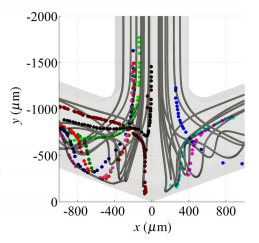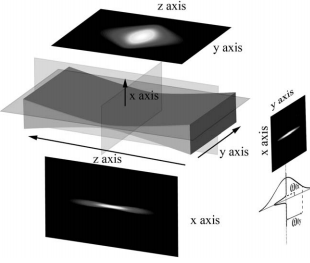Tunable acoustic gradient index of refraction lens
The tunable acoustic gradient index of refraction lens (or TAG lens) is an adaptive optics device filled with a fluid and driven by an acoustic wave. The very fast refractive index change induced results in a lens with tunable focal length at kHz rates, with applications in imaging and beam shaping.
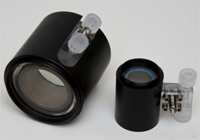
Featured publications
-
Variable optical elements for fast focus control

S.Y. Kang, M. Duocastella, and C.B. Arnold, Nat. Photonics (2020) discusses recent developments in the emerging field of high-speed variable-z-focus optical elements, which are driving important innovations in advanced imaging and materials processing applications. Three state-of-the-art key optical technologies that enable fast z-focus modulation are reviewed, along with a discussion of the implications of the new developments in variable optical elements and their impact on technologically relevant applications.| Full text| View at publisher
-
Optimization of ultrafast axial scanning parameters for efficient pulsed laser micro-machining

X. Du, S.Y. Kang, and C.B. Arnold, J. Mat. Proc. Tech (2020) studies an ultrafast axial scanning technique that asynchronously distributes laser pulses along the axial direction. With axial scanning, multi-pass groove machining with axial scanning on silicon as well as femtosecond laser cutting of battery separators exhibit an extended effective machining range and an improved machining efficiency for both focused and defocused surfaces.| Full text| View at publisher
-
Ultra-high-speed variable focus optics for novel applications in Advanced Imaging

M. K. Fu, T.-H. Chen, C. B. Arnold, M. Hultmark, Exp. Fluids. (2019) studied the robustness and behavior of lubricant-infused streamwise microgrooves in a turbulent channel flow facility. In the presence of external turbulent shear flow, a finite length of lubricant is found to be retained within the microtextures by a mechanism analogous to capillary rise, consistent with the observations of Wexler et al. (PRL 2015), while the remainder of the lubricant is driven out of the surface. This retention mechanism is exploited to maintain a lubricating layer over a larger surface area by using a novel chemical patterning technique. Chemical barriers are scribed along the streamwise length of the grooves. These periodic barriers disrupt the continuity of the streamwise groove and inhibit the downstream drainage of the lubricant. The effectiveness of this approach is evaluated in a turbulent channel flow with promising results.| Full text| View at publisher
-
Ultra-high-speed variable focus optics for novel applications in Advanced Imaging

S. Kang, E. Dotsenko, D. Amrhein, C. Theriault, and C. B. Arnold Proc. SPIE. (2018) presents the advances in imaging using an ultra-high-speed variable focus element, the TAG lens. The TAG lens enables new ways to acquire 3D information from an object using sound to adjust the index of refraction profile in a liquid and thereby achieving focal scanning rates greater than 100 kHz. | Full text | View at publisher
-
Ultrafast z-scanning for high-efficiency laser micro-machining

T.-H. Chen, R. Fardel, and C. B. Arnold, Light: Science & Applications (2018) demonstrates a new high-throughput micro-machining technique based on rapidly scanning the laser focal point along the optical axis using an acoustically driven variable focal length lens. This method has great potential for improving the micro-machining efficiency of conventional systems and also opens the door to applying laser machining to workpieces with uneven topography that have been traditionally difficult to process. | Full text | View at publisher
-
Phase behavior of disordered proteins underlying low density and high permeability of liquid organelles

M.-T. Wei, S. Elbaum-Garfinkle, A. S. Holehouse, C. C.-H. Chen, M. Feric, C. B Arnold, R. D. Priestley, R. V. Pappu, and C. P. Brangwynne, Nature Chemistry (2017) reveals how specific intrinsically disordered proteins phase separate to form permeable, low-density liquids while using a TAG-lens for ultafast scanning fluorescence correlation spectroscopy. | Full text | View at publisher
-
High-speed axial-scanning wide-field microscopy for volumetric particle tracking velocimetry
T.-H. Chen, J. T. Ault, H.A. Stone, C. B. Arnold, Exp. Fluids (2017) introduces a fast axial-scanning wide-field microscopy technique for volumetric particle tracking velocimetry by integrating a TAG lens, scanning at a frequency of 70 kHz, with a wide-field microscope to acquire images through the scanning volume every 7.14 s. With this high-speed 3D imaging technique, we were able to simultaneously capture multiple particle trajectories in the complex vortical flow within an arrow- shaped junction with a time resolution of sub-milliseconds. | Full text | View at publisher
-
Selectable light-sheet uniformity using tuned axial scanning
M. Duocastella, C. B, Arnold, and J. Puchalla, J. Microscopy. Res. Tech. (2017) introduces a simple dimensionless uniformity statistic to better characterize scanned light-sheets and experimentally demonstrate custom tailored uniformities up to a factor of 5 higher than those of unscanned elliptical beams. | Full text | View at publisher
-
Three-dimensional particle tracking via tunable color-encoded multiplexing

M. Duocastella, C. Theriault and C.B. Arnold, Optics Letters (2016) tracks particles in 3D with and a standard camera and no moving parts by splitting a three-color illumination into different planes using a tunable acoustic gradient (TAG) lens. | Full text | View at publisher
-
Enhanced depth of field laser processing
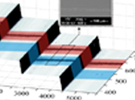
M. Duocastella and C. B. Arnold, Appl. Phys. Lett (2013) axially scans the focus of a laser system to enhance depth of field by an order of magnitude without lateral resolution loss. This approach obviates the need for z-focus control during laser processing. | Full text | View at publisher
-
Transient response in TAG lenses
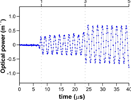
M. Duocastella and C. B. Arnold, J. Phys. D: App. Phys. (2013) characterizes the dynamics of a TAG lens at the initial moments of operation as a function of frequency and develop a model to predict the lens behavior at any given time. | Full text | View at publisher
-
Simultaneous imaging of multiple focal planes

M. Duocastella, B. Sun, and C. B. Arnold. J. Biomed. Opt. (2012) uses an ultra-high-speed liquid lens to provide simultaneous real-time imaging of multiple and selectable focal planes in a specimen. The method is demonstrated by imaging microparticles and cells flowing in 3D microfluidic channels. | Full text | View at publisher
Two photon microscopy with simultaneous standard and extended depth of field using an acoustic gradient index lens
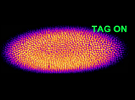
N. Olivier et al.,Opt. Lett., (2009) uses a TAG lens to achieve kHz rate DOF switching in a nonlinear microscope. Fast varifocus scanning and pseudo-Bessel beam excitation modulation strategies were used to take 4.5x-extended DOF images of developing embryos. | Full text | View at publisher
High-speed varifocal imaging with a tunable acoustic gradient index of refraction lens

A. Mermillod-Blondin, E. McLeod, & C. B. Arnold, Opt. Lett., (2008) uses a TAG lens as a fast varifocal element with the ability of rapid selection and modification of the effective focal length at time scales under 1 us. The wave-front curvature applied to the incident light is quantified as a function of time, and single-frame imaging is demonstrated. | Full text | View at publisher
Dynamic pulsed-beam shaping using a TAG lens in the near UV

A. Mermillod-Blondin, E. McLeod, & C. B. Arnold, Appl. Phys. A., (2008) describes a method to generate doughnut-shaped beams from an input Gaussian source using a TAG lens. Laser micromachining of surface features with different shapes and sizes is accomplished by synchronizing the TAG lens to a 355 nm pulsed nanosecond laser. | Full text | View at publisher
Optical analysis of time-averaged multiscale Bessel beams generated by a tunable acoustic gradient index of refraction lens

E. Mcleod & C.B. Arnold, Appl. Opt. (2008) analyzes multiscale Bessel beams created using a TAG lens both experimentally and theoretically using both geometric and Fourier optics. Tunability of ring spacing, central spot size, and working distance is also demonstrated. | Full text | View at publisher
-
All TAG lens publications
- M. Duocastella and C. B. Arnold, “Enhanced depth of field laser processing using an ultra-high-speed axial scanner,” Appl. Phys. Lett., 102 061113-7 (2013) | Full text | View at publisher
- M. Duocastella and C. B. Arnold, “Transient response in ultra-high speed liquid lenses,” J. Phys. D: Appl. Phys., 46 075102-09 (2013) | Full text | View at publisher
- M. Duocastella, B. Sun, and C. B. Arnold, "Simultaneous imaging of multiple focal planes for three-dimensional microscopy using ultra-high-speed adaptive optics," J. Biomed. Opt., 17 (2012) | Full text | View at publisher
- N. Olivier, A. Mermillod-Blondin, C. B. Arnold, and E. Beaurepaire, “Two photon microscopy with simultaneous standard and extended depth of field using an acoustic gradient index lens”, Opt. Lett., 34, 1684-1686 (2009) | Full text | View at publisher
- A. Mermillod-Blondin, E. McLeod, and C. B. Arnold, “High-speed varifocal imaging with a tunable acoustic gradient index of refraction lens,” Opt. Lett. 33, 2146-2148 (2008) | Full text | View at publisher
- A. Mermillod-Blondin, E. McLeod, and C. B. Arnold, “Dynamic pulsed-beam shaping using a TAG lens in the near UV,” Appl. Phys. A. 93, 231-234 (2008) | Full text | View at publisher
- E. McLeod and C. B. Arnold, “Optical analysis of time-averaged multiscale Bessel beams generated by a tunable acoustic gradient index of refraction lens”, Appl. Opt. 47, 3609-3618 (2008) | Full text | View at publisher
- T. Lipp*, A. Mermillod-Blondin, E. McLeod, C. B. Arnold, “Rapid beam-shaping and focusing using tunable acoustic gradient index lenses,” in 21st Solid State and Diode Laser Technology Review Technical Digest, 7-11 (2008) (non-refereed meeting paper) | Full text
- C. B. Arnold and E. McLeod, “A new approach to adaptive optics for materials processing: Acousto-optic beam shaping brings a new dimension to adaptive optics,” Photonics Spectra, 41(11), 78-84 (2007) (invited) | Full text
- E. McLeod and C. B. Arnold, “Mechanics and refractive power optimization of tunable acoustic gradient lenses,” J. Appl. Phys. 102, 033104:1-9 (2007) | Full text
- E. McLeod and C. B. Arnold, “Complex beam sculpting with tunable acoustic gradient index lenses,” in Complex Light and Optical Forces, ed. D. L. Andrews, International Society for Optical Engineering (SPIE) 6483, 64830I (2007) | Full text
- E. McLeod, A. B. Hopkins*, and C. B. Arnold, “Multiscale Bessel beams generated by a tunable acoustic gradient index of refraction lens,” Opt. Lett, 31, 3155-3157 (2006) | Full text
- T. Tsai*, E. McLeod, and C. B. Arnold, “Generating Bessel beams with a tunable acoustic gradient index of refraction lens,” in Optical Trapping and Optical Micromanipulation III, eds. K. Dholakia and G. Spalding, International Society for Optical Engineering (SPIE), 6326, 63261F (2006) | Full text
